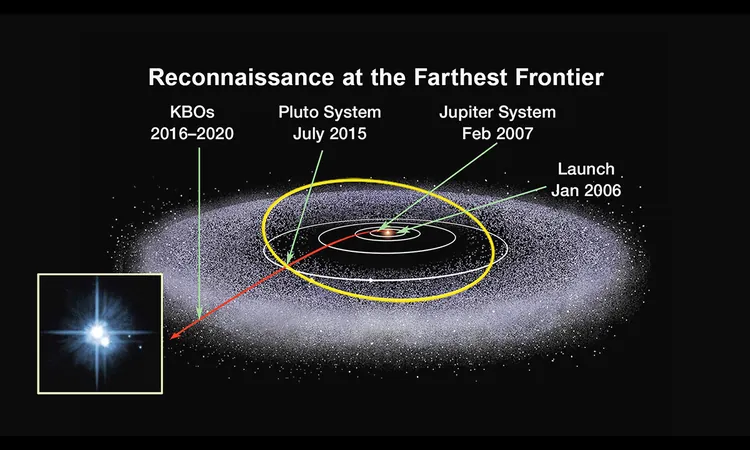
New Discoveries in the Kuiper Belt: Are There Hidden Worlds Beyond the Solar System?
2024-10-04
Author: Chun
In the remote corridors of our Solar System, a fascinating collection of comets, dwarf planets, and other celestial objects known as the Kuiper Belt extends beyond Neptune. Recently, a monumental discovery has emerged: scientists are uncovering previously unseen objects lurking far beyond what was thought possible.
Previously, astronomers believed that the Kuiper Belt ended at about 48 astronomical units (AU) from the Sun - equivalent to around 7.2 billion kilometers. This perspective has dramatically shifted thanks to the groundbreaking work of NASA's New Horizons team, which recently identified 11 new objects located between 60 and 80 AU from the Sun. This revelation indicates that rather than being empty space, these regions house a hidden treasure trove of celestial bodies, suggesting that our Solar System is much larger than once believed.
What Lies Beyond?
The newfound objects are enigmatic pinpoints of light, so faint that many characteristics remain uncertain. New Horizons’ researcher Wesley Fraser stated, “Until we can get closer, we will not know if they are similar to other Kuiper Belt objects.” As the spacecraft continues its voyage, it employs its LORRI (Long Range Reconnaissance Imager) alongside the Subaru Telescope, a partnership that leverages their combined capabilities to uncover the mysteries of these distant realms.
Interestingly, these newly discovered objects are perched on the edge of the heliosphere — the boundary where the solar wind ceases and interstellar space begins. This transition zone, often described as a protective bubble formed by the Sun's magnetic field, is crucial for shielding planets from cosmic radiation. The unique conditions at these extreme distances may influence the physical and chemical properties of these objects, potentially making them starkly different from their closer relatives in the Kuiper Belt.
The Case of Strange Colors
Fraser hypothesizes that these objects might exhibit a reddish, dark surface devoid of water ice, which is relatively common among closer Kuiper Belt residents. Previous studies suggest that features like these could emerge from organic compounds being irradiated by cosmic rays, transforming them into a thick, red sludge. Given the extreme distances and conditions these objects face, they may have a different composition, providing insights into the formation and evolution of our Solar System.
Redefining Solar System Formation
These revelations raise essential questions regarding the origins of our Solar System. If the Kuiper Belt is significantly more extensive than initially postulated, does this mean our Solar System is more typical compared to the distant exoplanetary systems we observe? This broadening of our understanding could reshape the timeline and methods of Solar System formation.
Marc Buie, another researcher on the New Horizons team, emphasized the importance of studying objects in the Kuiper Belt as fundamental to understanding the early moments of planet formation. Previous discoveries, like the unique two-lobed object Arrokoth, have already challenged conventional theories about how celestial bodies form and evolve.
The Quest for Companionship: Binary Systems
As the search continues, scientists are particularly interested in whether these newly detected objects exist in binary systems, where two such bodies orbit a common center. Binary systems are crucial for shedding light on the dynamics of planetary formation and the history of celestial interactions.
Interestingly, New Horizons has been experiencing an unexpected uptick in dust density as it travels further into the Kuiper Belt. This observation suggests the presence of numerous celestial bodies colliding and generating debris, an anomaly compared to existing models. Alan Stern, the mission's principal investigator, notes, "The Solar System seems to be getting dustier as we venture further out, hinting at a possibly massive population of colliding objects.”
Future Explorations and the Hopes for New Discoveries
The earlier shift in NASA's focus towards heliophysics led to uncertainty about additional close encounters with Kuiper Belt Objects (KBOs). However, the unexpected detection of these distant objects has renewed hope for future flybys. If successful, New Horizons may once again gather invaluable data to compare these distant outliers with their closer counterparts.
The work of the New Horizons mission and its collaboration with telescopes like Subaru could revolutionize our understanding of not just our Solar System, but of planetary systems across the cosmos. The implications of this ongoing research could unlock profound secrets about the nature and origin of the worlds around us.
With the universe still holding countless unexplored mysteries, each new discovery brings with it the promise of new knowledge—one that might forever alter our cosmic perspective.



 Brasil (PT)
Brasil (PT)
 Canada (EN)
Canada (EN)
 Chile (ES)
Chile (ES)
 España (ES)
España (ES)
 France (FR)
France (FR)
 Hong Kong (EN)
Hong Kong (EN)
 Italia (IT)
Italia (IT)
 日本 (JA)
日本 (JA)
 Magyarország (HU)
Magyarország (HU)
 Norge (NO)
Norge (NO)
 Polska (PL)
Polska (PL)
 Schweiz (DE)
Schweiz (DE)
 Singapore (EN)
Singapore (EN)
 Sverige (SV)
Sverige (SV)
 Suomi (FI)
Suomi (FI)
 Türkiye (TR)
Türkiye (TR)